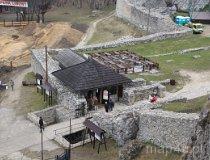The ruins of the Ogrodzieniec Castle in Podzamcze - Station 01 – Przedzamcze
Description
We warmly welcome you in Podzamcze. During our tour you will have the opportunity to get to know the unique qualities of the village. On the entire route are planned 13 stations talking about them.
With a device equipped with Internet access you can play the tracks with numbers corresponding to the number of station. Each of them should be played at the point marked on the map by the relative number. To each of them is attached a photo gallery, showing the valuable spots.
The surrounding of Podzamcze are very diverse in terms of attractions. There are religious buildings, bunkers from World War II, a group of rocks, and Mount Birów with a reconstructed castle town. And the most precious monument, the Ogrodzieniec Castle (photo 07.01.001).
The castle is located on Janowski Mountain, the highest hill in Jura Krakowsko-Częstochowska. It is the best preserved building of the szlak Orlich Gniazd (Eagles' Nests Trail). It was built of hard limestone and dolomite, so that has survived hundreds of years.
The first castle town on Janowski Mountain existed already in the 12th century. It consisted of a few cottages enclosed on three sides by rocks. In 1241 the village was plundered and in its place was erected a castle made of stone.
By that time its owner was the Włodków family, but, since 1470, it was changing owners until in 1523 fell into the hands of the Boners. Seweryn Boner in the years 1530-1545 expanded it. At that time it become a beautiful Renaissance fortress comparable to the Wawel Castle.
To the fall of the castle contributed the Swedish invasions in 1655 and 1702. The castle was abandoned 100 years later and began to fall into disrepair.
In the 20th century the walls began to be secured. After World War II, archaeological work were carried out here and the castle started to be available for tourists.
The stronghold in Podzamcze occupies an area of 3.5 hectares, 3 of which is occupied by the ward. The entrance is located near the Cash desk (photo 07.01.002). Directly in front of the walls was a dry moat, which remains are still visible today. After entering the ward, on the right we see the body of the castle. Looking then to the left, you can see the remains of coach house and stables (photo 07.01.003). This area also served for representative functions: tournaments took place and reunions were held here. In moment of danger, the local population would seek protection within the walls. In the ward it was cultivated corn and grazed cattle. A stone path leads to the keep. On its turn under the walls there was once a distillery and brewery.
Before you enter the castle we turn your attention to the walls.





